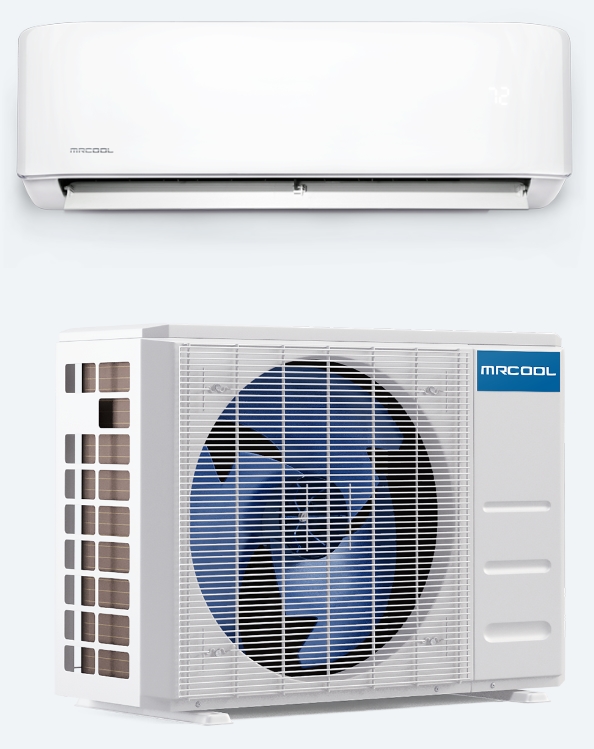Does a Heat Pump Work in both Cold and Hot Temperatures?

Does a Heat Pump Work in both Cold and Hot Temperatures?
Reprinted with permission from Mr Cool
If you’re looking for cost-effective, energy-efficient and low-maintenance ways to heat and cool your home, then a heat pump may be the solution. Though heat pumps are becoming increasingly popular in new residential homes and as furnace or air conditioning replacements in existing homes, there are still misconceptions about how heat pumps work and what types of climates they’re suitable for.
This guide to heat pumps explains how these devices provide both cooling and heating. We also cover what you need to know about operating a heat pump in either extremely hot or freezing cold temperatures.
How Does a Heat Pump Work?
A heat pump is a device that provides heating and cooling to an indoor residential space using the principle of heat transfer. It’s an energy-efficient alternative to traditional heating and cooling options like furnaces and air conditioners.
These all-in-one solutions come with both an indoor and an outdoor unit, each with its unique role depending on the season. The indoor unit gets mounted in a central location inside your home, typically toward the ceiling. The outdoor unit gets installed in an unobstructed location outside your home, typically in the side or backyard.
Below is how a heat pump works in heating mode:
- The outdoor unit extracts heat from the cold, outdoor air, compressing it to maximize its heat energy.
- The heat energy is transferred to the indoor unit via a refrigerant line.
- The indoor unit further heats up the air by condensing the air as a fan blows it across a coil.
- The indoor unit circulates the warm air throughout the home via ducts and vents.
And here is how a heat pump works in cooling mode:
- The indoor unit pulls warm air from inside the home into the unit using a fan.
- The indoor unit fan blows the warm air across a coil containing refrigerant that absorbs the heat, cooling it down.
- The cool air gets circulated throughout the home.
- The refrigerant that absorbed the heat energy evaporates into a gas, which gets compressed and sent outside via the outdoor unit.
Both the heating and cooling modes repeat on a continuous cycle to maintain the desired ambient temperature.
Can a Heat Pump Work in Cold Weather?
Heat pumps are designed to work year-round, meaning they’re both a heating and cooling solution. Heat pumps are necessary in cold weather, as they keep a home warm. But, like all powered devices, heat pumps will reach a certain maximum efficiency rating, which dwindles in extreme conditions. When the outdoor temperature is extremely cold, a heat pump typically becomes less efficient at heating a home. That’s because it has to work harder to produce heat, meaning it uses more energy.
To heat air in the wintertime, the heat pump needs to be able to cool down the refrigerant so it’s cooler than the outside air. How much colder the refrigerant gets than the outside air is what determines its efficiency. Therefore, when temperatures are extremely low, the refrigerant can’t get any colder and the unit loses its ability to extract heat from the air.
Heat pumps have efficiency ratings measured in British thermal units per hour (Btu/hr), which is how much heat energy the unit can provide to a space. Thermal output fluctuates depending on the outdoor temperature. So, a unit that delivers 50,000 Btu/hr at 50 degrees Fahrenheit might drop to a 40,000-Btu/hr output at 35 degrees Fahrenheit.
Can Heat Pumps Work Below Freezing?
Manufacturers provide a heat pump minimum temperature rating for a certain temperature range, traditionally with a minimum operating efficiency at around 30-40 degrees Fahrenheit. However, many of today’s heat pump units are designed with extremely efficient heating capabilities, meaning some cold-climate heat pumps can continue to pull heat in temperatures as low as 5 degrees Fahrenheit. The 12k, 18k, and 24k BTU 4th Gen DIY ductless mini-splits can heat in temperatures as low as -13 degrees Fahrenheit.
In climates where temperatures drop below 20 or 30 degrees Fahrenheit frequently, home builders and homeowners typically install a backup heat source to compensate for the time when a heat pump isn’t sufficient. These emergency sources of heat are usually electric baseboard heaters or gas-powered heaters.
With cold-climate heat pumps, homeowners can drastically cut their conventional heating costs in the winter by taking advantage of these high-efficiency heating units.
Do Heat Pumps Work in Hot Weather?
Many people think of heat pumps as simply a household heating solution. But heat pumps work to cool homes, too, and are capable of working in hot weather, just like an air conditioner.
According to the Department of Energy, heat pumps work as well at conditioning an equivalent-sized space as an air conditioner but they dehumidify better and work more efficiently. For this reason, many households are switching from air conditioning units to heat pumps to replace their cooling needs. Since heat pumps also provide heating, it means that homeowners now have a single unit to manage rather than an air conditioner and a furnace.
Just as heat pumps have to work harder in the winter to pull heat from the extremely cold air, these units also work overtime in the summer to cool down hot air. If outdoor temperatures reach extreme highs of 95-100 degrees Fahrenheit, then the heat pump’s efficiency will be affected, and it will be less able to provide comfortable cooling abilities.
New, high-efficiency heat pump units are becoming increasingly more capable of cooling down residential spaces when temperatures reach extreme highs. Heat pumps are also effective in humid climates and can keep pace with heat waves or spikes in temperature.
At What Temperature Do Heat Pumps Lose Their Efficiency?
Heat pumps are designed and engineered to work efficiently, making them a cost-effective and energy-efficiency alternative to many conventional cooling and heating sources. However, their efficiency wanes when temperatures veer to the extremes.
What’s the lowest temperature a heat pump will work? Generally speaking, most heat pumps operate at their top efficiency levels while outdoor temperatures are 30-40 degrees Fahrenheit or higher. Any lower than that and the unit will consume more energy trying to heat your home, increasing your energy bills.
Thankfully, there are steps that homeowners can take to improve heat pump heating efficiency, including:
- Install wind baffles: In extremely cold climates, it’s recommended to install wind baffles on the outdoor unit. Wind baffles prevent air from blowing into and through the outdoor unit to preserve efficient performance during low temperatures. Also acting as air diverters, wind baffles direct air upward and away from the outdoor unit, protecting nearby structures and obstructions from expelled air.
- Perform a winter cleaning: All equipment performs best when it’s been well-maintained and is in good working condition. During the winter, your heat pump will undergo heavy use, so make sure the filter is clean and replace it if necessary. You can also call a professional to have your heat pump inspected to ensure it’s functioning properly.
- Winterize your outdoor unit: During the winter, the outdoor unit coil can start to accumulate ice. The outdoor unit is equipped with a defrost setting that will automatically use hot gas to melt ice from the coil. However, if too much snow or debris accumulates in front of the outdoor unit, it’s important to clear it away. If you live in a rainy or snowy climate, you’ll also need to install a gutter or rainwater diverter to prevent roof water runoff from damaging the outdoor unit.
Heat Pump Cooling Efficiency
Heat pumps are becoming an increasingly preferred option to air conditioning units in warm-weather climates. That’s because they operate extremely efficiently, even at high temperatures. While heat pumps can work in hot weather, the hotter it gets, the less efficient they may become. When it’s 90 degrees Fahrenheit outside or more, it may take a heat pump several hours to bring the indoor ambient temperature down to a comfortable 70 degrees.
The ideal heat pump effective operating temperature for cooling is 20 degrees lower than the outdoor temperature. To maximize heat pump cooling efficiency in the summer, you should never set your heat pump temperature higher than 80 degrees Fahrenheit, which is sufficient on the hottest days of 100-degree weather.
How to Heat Your Home When Temperatures Are Low
Be prepared to properly manage your heat pump during winter cold snaps. Taking certain precautions and following some best practices can help improve heat pump efficiency when it’s cold out.
Below are some tips on how to heat your home with a heat pump during the winter:
- Use the heat pump in moderation: Keep your heat pump’s temperature set to a moderate setting. Don’t set it higher during the winter than is necessary — between 66 and 70 degrees Fahrenheit — and avoid running it continuously. Set the heat pump to heat mode rather than auto to reduce the amount of energy that’s needed during auto mode, which automatically switches between heating and cooling.
- Never cover a heat pump during the winter: Some people mistakenly believe they need to cover or protect their outdoor unit when temperatures drop. Heat pump outdoor units need an exhaust clearance of 2 feet. Your outdoor unit does not need to be covered during the winter to protect it, as it’s designed to withstand cold, outdoor conditions.
- Use the heat pump according to instructions: Follow the manufacturer’s instructions, including seasonal directions for how to use it during the winter. Checking out the manual helps you better manage your heat pump and maximize its efficiency, and it will also protect your warranty if the unit happens to malfunction.
- Avoid switching to emergency heat: Heat pumps with emergency heat settings will automatically switch to the supplemental heating source as necessary. Avoid manually switching to emergency heat unless you are sure your heat pump isn’t working. Switching your heat pump to emergency heat manually may cause your heat to be supplied entirely by the emergency source, leading to a major increase in energy consumption and costs.
How to Cool Your Home When Temperatures Are High
Using a heat pump in the summer to cool your home can be an energy-efficient and cost-effective solution for improved comfort. However, there are certain steps homeowners can take to maximize the use of their heat pumps for summer cooling.
Below are some tips on using heat pump cooling during the summer:
- Use a high-powered fan: Fans blow air throughout the cooled space, helping circulate cold air and bring the ambient temperature down so the heat pump can work more efficiently. Adding fans to your home to help circulate air can speed up the amount of time it takes to cool a space.
- Set up a dehumidifier: Dehumidifiers reduce air humidity levels, making your home feel cooler. Since heat transfers through humid air more easily, reducing humidity lowers the air temperature of a space.
- Shut the doors and vents in unused rooms: If you only need to cool certain areas of the home, shut the doors and vents to unused rooms. This allows the heat pump to only consume enough energy as needed to keep the smaller space cool.
- Close the blinds and curtains: Keep your blinds or curtains closed during the day to prevent direct sunlight from entering your home. The sun heats up homes dramatically during the day, so preventing heat transfer can help save energy as your home will stay cooler naturally.
- Perform summer cleaning: Just as you want to clean and winterize your heat pump as the temperatures drop, you’ll also want to inspect your heat pump in the summer. Make sure the coils are intact and inspect the refrigerant levels. Clean or change the air filters and hose down your outdoor unit to remove any grime and dirt buildup.
Is a Heat Pump Right for Your Climate?
No matter your climate, you can find a heat pump that’s designed to handle your region’s year-round conditions. Though heat pumps lose efficiency in extremely cold weather, modern cold-climate heat pumps are built to perform under freezing conditions thanks to it’s modern design capabilities.
Choose MRCOOL for Reliable Heating and Cooling
Heat pumps are practical, energy-efficient and high-performing heating and cooling solutions for residential homes. Households across the U.S. are converting their heating and cooling systems to heat pumps and saving money on their energy bills.
If you’re considering switching to a heat pump, contact RONUSA.COM today. To learn more about our heat pump systems, including our single and multi-zone heat pump systems, please visit our website at RONUSA.COM, or call us at 888-314-5310.

About the Author:
Ron Garrigus; Owner of “ronusa.com” was previously a highly successful HVAC contractor in Dallas, TX. for almost 20 years. He greatly enjoys sharing his knowledge with other people who are seeking advice in regard to selecting the proper HVAC system to meet their needs. You can always contact him by phone at (888) 314-5310; or you can send him an e-mail at sales@ronusa.com
WE’RE A FACTORY AUTHORIZED ONLINE RETAILER!

WE WOULD BE GLAD TO MEET YOUR NEEDS!


